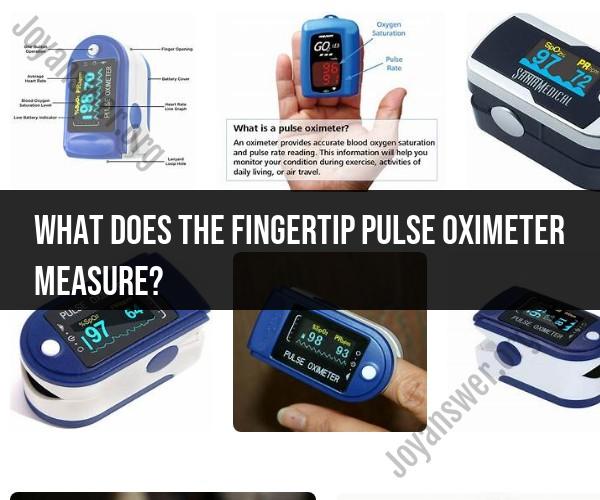What does the fingertip pulse oximeter measure?
A fingertip pulse oximeter is a portable medical device that measures two critical parameters related to blood and oxygen in the body:
Pulse Rate (Heart Rate): A pulse oximeter measures your heart rate, often expressed in beats per minute (bpm). It does this by detecting the pulsatile flow of blood through your arteries. By analyzing the variations in the intensity of the light absorbed by the pulsating blood, the device calculates your heart rate. It provides a real-time display of your pulse rate, allowing you to monitor changes in heart rate over time.
Oxygen Saturation (SpO2): A pulse oximeter also measures oxygen saturation, which is abbreviated as SpO2. Oxygen saturation represents the percentage of hemoglobin in your blood that is carrying oxygen. The pulse oximeter uses light to determine how much oxygen is bound to hemoglobin in your red blood cells. An SpO2 reading of 100% indicates that nearly all hemoglobin is carrying oxygen, while lower percentages suggest lower oxygen levels in the blood.
Fingertip pulse oximeters are non-invasive and work by shining light through your fingertip and measuring how much of the light is absorbed by the blood. Oxygenated blood absorbs light differently from deoxygenated blood, allowing the device to calculate oxygen saturation.
Fingertip pulse oximeters are commonly used in medical settings, such as hospitals and clinics, as well as by individuals at home for various purposes:
Monitoring Respiratory Conditions: People with respiratory conditions like chronic obstructive pulmonary disease (COPD), asthma, or sleep apnea may use pulse oximeters to monitor their oxygen levels and pulse rate to assess their respiratory function.
Monitoring During Exercise: Athletes and fitness enthusiasts often use pulse oximeters to track their pulse rate and oxygen saturation during workouts to optimize training and avoid overexertion.
Monitoring in High-Altitude Settings: In high-altitude environments, where oxygen levels are lower, individuals may use pulse oximeters to monitor oxygen saturation to prevent altitude sickness and hypoxia.
Home Health Monitoring: People with certain health conditions, such as heart disease, may use pulse oximeters for home monitoring to track their overall health and detect potential issues early.
It's important to note that while fingertip pulse oximeters are valuable for obtaining quick and convenient readings of pulse rate and oxygen saturation, they may have limitations and may not be a substitute for more comprehensive medical evaluations. If you have concerns about your health or the accuracy of pulse oximeter readings, it's advisable to consult with a healthcare professional.
Fingertip Pulse Oximeter: A Vital Sign Measurement Device
A fingertip pulse oximeter is a small, portable device that is used to measure oxygen saturation levels and heart rate. It works by passing a beam of light through the finger and measuring how much light is absorbed by the blood. The amount of light that is absorbed depends on the amount of oxygen in the blood.
Understanding the Role and Significance of Pulse Oximetry
Pulse oximetry is a non-invasive and painless procedure that can be used to monitor a person's oxygen saturation levels and heart rate. Oxygen saturation levels are a measure of how much oxygen is being carried in the blood. Heart rate is the number of times the heart beats per minute.
Pulse oximetry is used in a variety of settings, including hospitals, clinics, and at home. It is a valuable tool for monitoring people with respiratory conditions, such as asthma and COPD. It is also used to monitor people during surgery and anesthesia.
Using and Maintaining a Fingertip Pulse Oximeter
To use a fingertip pulse oximeter, simply place your finger inside the device and turn it on. The oximeter will display your oxygen saturation levels and heart rate.
It is important to follow the manufacturer's instructions carefully when using a fingertip pulse oximeter. Here are some general tips:
- Make sure your finger is clean and dry.
- Place your finger in the oximeter so that the sensor is centered on your fingertip.
- Keep your finger still while the oximeter is taking your reading.
- Clean the oximeter after each use with a mild soap and water solution.
Monitoring Oxygen Levels and Heart Rate with Oximetry
If you are using a fingertip pulse oximeter to monitor your oxygen saturation levels or heart rate, it is important to be aware of the normal ranges. Normal oxygen saturation levels are between 95% and 100%. Normal heart rates vary depending on age and activity level.
If your oxygen saturation levels are below 90% or your heart rate is above 100 beats per minute, you should seek medical attention.
Real-Life Experiences and Tips on Pulse Oximeter Usage
I personally use a fingertip pulse oximeter to monitor my oxygen saturation levels and heart rate during exercise. I find it to be a helpful tool for ensuring that I am not overexerting myself.
If you are considering using a fingertip pulse oximeter, I recommend talking to your doctor first. They can help you to determine if it is the right device for you and can teach you how to use it correctly.
Here are some additional tips on pulse oximeter usage:
- If you have cold hands or feet, warm them up before using the oximeter. This will help to improve the accuracy of the reading.
- If you have nail polish on, remove it before using the oximeter. Nail polish can interfere with the sensor's ability to read your oxygen saturation levels.
- If you have any concerns about your oxygen saturation levels or heart rate, be sure to talk to your doctor.











